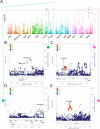Identifying Genetic Sources of Phenotypic Heterogeneity in Orofacial Clefts by Targeted Sequencing
- PMID: 28762674
- PMCID: PMC5549861
- DOI: 10.1002/bdr2.23605
Identifying Genetic Sources of Phenotypic Heterogeneity in Orofacial Clefts by Targeted Sequencing
Abstract
Background: Orofacial clefts (OFCs), including nonsyndromic cleft lip with or without cleft palate (NSCL/P), are common birth defects. NSCL/P is highly heterogeneous with multiple phenotypic presentations. Two common subtypes of NSCL/P are cleft lip (CL) and cleft lip with cleft palate (CLP) which have different population prevalence. Similarly, NSCL/P can be divided into bilateral and unilateral clefts, with unilateral being the most common. Individuals with unilateral NSCL/P are more likely to be affected on the left side of the upper lip, but right side affection also occurs. Moreover, NSCL/P is twice as common in males as in females. The goal of this study is to discover genetic variants that have different effects in case subgroups.
Methods: We conducted both common variant and rare variant analyses in 1034 individuals of Asian ancestry with NSCL/P, examining four sources of heterogeneity within CL/P: cleft type, sex, laterality, and side.
Results: We identified several regions associated with subtype differentiation: cleft type differences in 8q24 (p = 1.00 × 10-4 ), laterality differences in IRF6, a gene previously implicated with wound healing (p = 2.166 × 10-4 ), sex differences and side of unilateral CL differences in FGFR2 (p = 3.00 × 10-4 ; p = 6.00 × 10-4 ), and sex differences in VAX1 (p < 1.00 × 10-4 ) among others.
Conclusion: Many of the regions associated with phenotypic modification were either adjacent to or overlapping functional elements based on ENCODE chromatin marks and published craniofacial enhancers. We have identified multiple common and rare variants as potential phenotypic modifiers of NSCL/P, and suggest plausible elements responsible for phenotypic heterogeneity, further elucidating the complex genetic architecture of OFCs. Birth Defects Research 109:1030-1038, 2017. © 2017 Wiley Periodicals, Inc.
Keywords: complex trait; genetic epidemiology; orofacial cleft.
© 2017 Wiley Periodicals, Inc.
Figures




References
-
- Al Chawa T, Ludwig KU, Fier H, Potzsch B, Reich RH, Schmidt G, Braumann B, Daratsianos N, Bohmer AC, Schuencke H, Alblas M, Fricker N, Hoffmann P, Knapp M, Lange C, Nothen MM, Mangold E. Nonsyndromic cleft lip with or without cleft palate: Increased burden of rare variants within Gremlin-1, a component of the bone morphogenetic protein 4 pathway. Birth defects research Part A, Clinical and molecular teratology. 2014 - PubMed
-
- Armit C, Venkataraman S, Richardson L, Stevenson P, Moss J, Graham L, Ross A, Yang Y, Burton N, Rao J, Hill B, Rannie D, Wicks M, Davidson D, Baldock R. eMouseAtlas, EMAGE, and the spatial dimension of the transcriptome. Mammalian genome : official journal of the International Mammalian Genome Society. 2012;23(9-10):514–524. - PMC - PubMed
-
- Attanasio C, Nord AS, Zhu Y, Blow MJ, Li Z, Liberton DK, Morrison H, Plajzer-Frick I, Holt A, Hosseini R, Phouanenavong S, Akiyama JA, Shoukry M, Afzal V, Rubin EM, FitzPatrick DR, Ren B, Hallgrimsson B, Pennacchio LA, Visel A. Fine tuning of craniofacial morphology by distant-acting enhancers. Science. 2013;342(6157):1241006. - PMC - PubMed
-
- Beaty TH, Murray JC, Marazita ML, Munger RG, Ruczinski I, Hetmanski JB, Liang KY, Wu T, Murray T, Fallin MD, Redett RA, Raymond G, Schwender H, Jin SC, Cooper ME, Dunnwald M, Mansilla MA, Leslie E, Bullard S, Lidral AC, Moreno LM, Menezes R, Vieira AR, Petrin A, Wilcox AJ, Lie RT, Jabs EW, Wu-Chou YH, Chen PK, Wang H, Ye X, Huang S, Yeow V, Chong SS, Jee SH, Shi B, Christensen K, Melbye M, Doheny KF, Pugh EW, Ling H, Castilla EE, Czeizel AE, Ma L, Field LL, Brody L, Pangilinan F, Mills JL, Molloy AM, Kirke PN, Scott JM, Arcos-Burgos M, Scott AF. A genome-wide association study of cleft lip with and without cleft palate identifies risk variants near MAFB and ABCA4. Nature genetics. 2010;42(6):525–529. - PMC - PubMed
-
- Beaty TH, Ruczinski I, Murray JC, Marazita ML, Munger RG, Hetmanski JB, Murray T, Redett RJ, Fallin MD, Liang KY, Wu T, Patel PJ, Jin SC, Zhang TX, Schwender H, Wu-Chou YH, Chen PK, Chong SS, Cheah F, Yeow V, Ye X, Wang H, Huang S, Jabs EW, Shi B, Wilcox AJ, Lie RT, Jee SH, Christensen K, Doheny KF, Pugh EW, Ling H, Scott AF. Evidence for gene-environment interaction in a genome wide study of nonsyndromic cleft palate. Genetic epidemiology. 2011;35(6):469–478. - PMC - PubMed
MeSH terms
Grants and funding
LinkOut - more resources
Full Text Sources
Other Literature Sources
Medical
Miscellaneous

